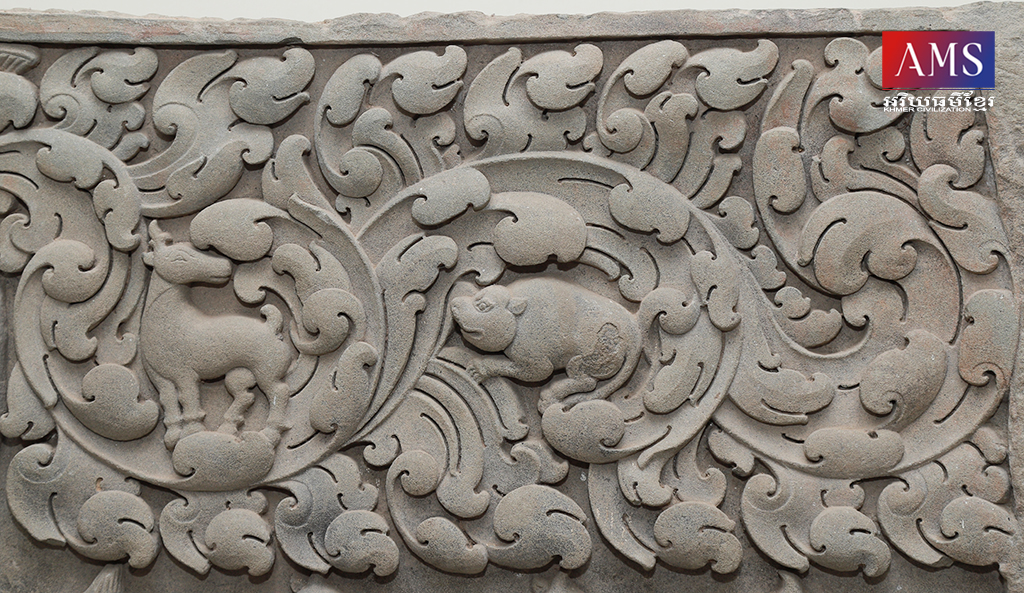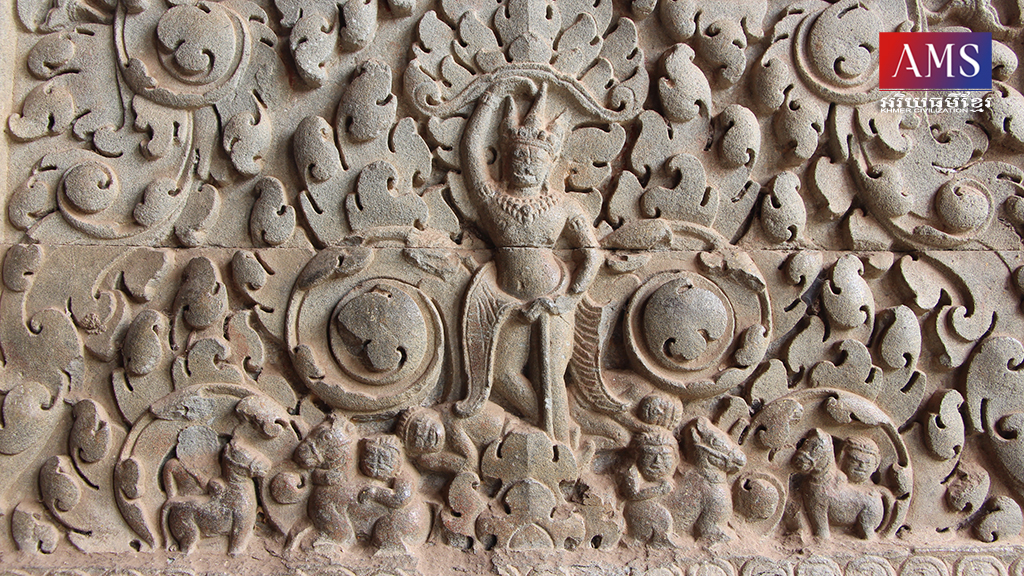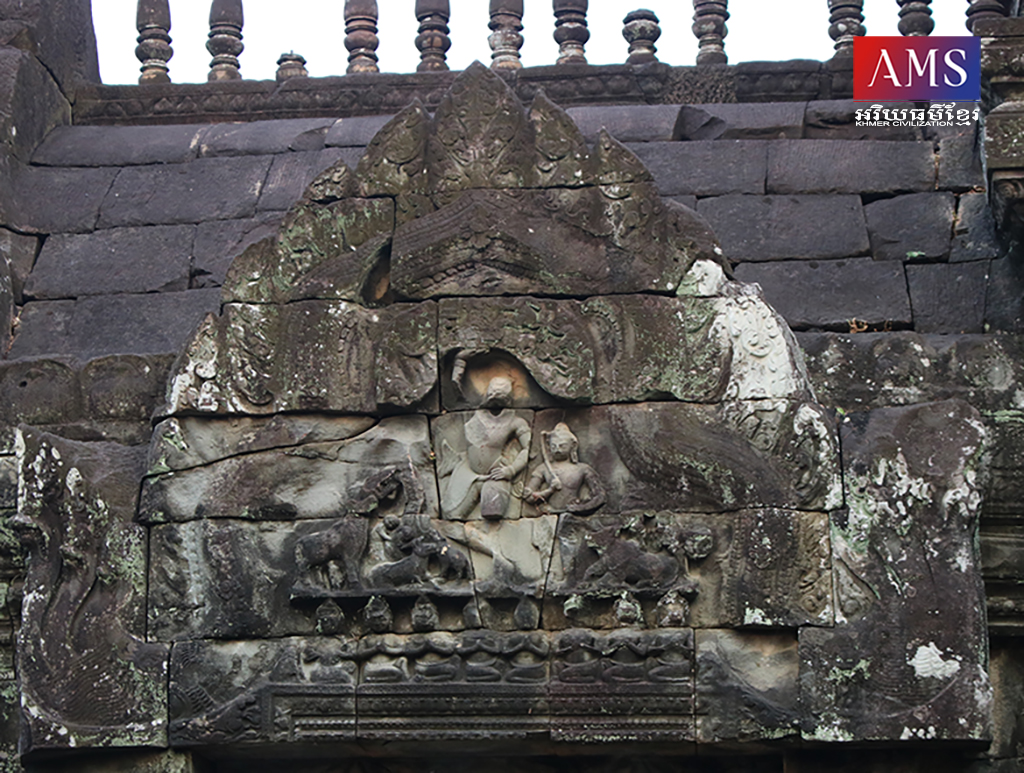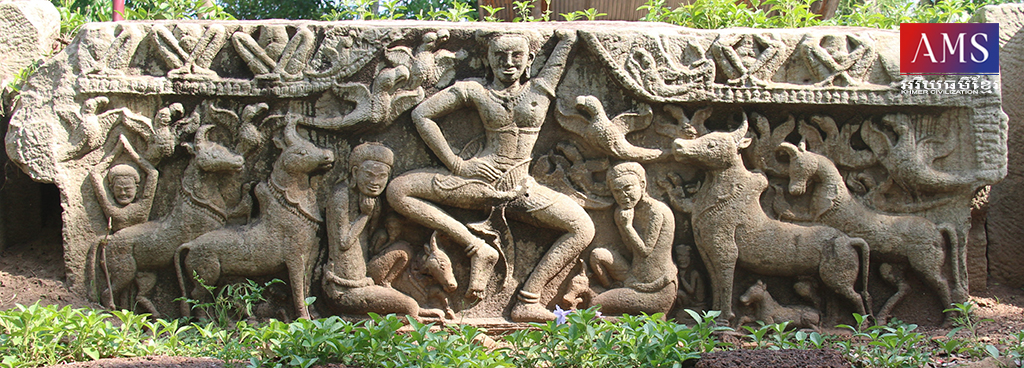នៅក្នុងសិល្បៈខ្មែរ ចម្លាក់ព្រះក្រឹស្ណទ្រភ្នំគោវធ៌ន ចាប់ផ្តើមមានតាំងពីរវាងស.វ.ទី៦មកម្ល៉េះ ប៉ុន្តែគេឆ្លាក់ជាចម្លាក់ទោល។ លុះមកដល់ស.វ.ទី១០មក ចម្លាក់ព្រះក្រឹស្ណទ្រភ្នំគោវធ៌ន ចាប់ផ្តើមមានភាពល្បីល្បាញយ៉ាងខ្លាំងនៅក្នុងសង្គមខ្មែរ ដូចឃើញឆ្លាក់នៅតាមសមាសធាតុជាច្រើននៃប្រាសាទ ដូចជា ហោជាង ផ្តែរទ្វារ សសរផ្អោប ជញ្ជាំង ។ល។ គេច្រើនឆ្លាក់រូបព្រះក្រឹស្ណមានរាងសង្ហា មើលទៅមុះមុតក្លាហាន និងមានឫទ្ធានុភាពខ្លាំងខ្លាអាចលើកភ្នំគោវធ៌នបាន។ មិនត្រឹមតែចម្លាក់ទេ សិលាចារឹកខ្មែរក៏មានរៀបរាប់អំពីទ្រង់ដែរ ដូចយើងឃើញនៅក្នុងសិលាចារឹកប្រាសាទប្រែរូប K.806 ស្លោកទី៨៦។ ដោយឡែក ចម្លាក់ព្រះក្រឹស្ណទ្រភ្នំនេះមានភាពកម្រខ្លាំងណាស់នៅតំបន់ប្រាសាទសំបូរព្រៃគុក ពោល គឺគេរកឃើញតែមួយផ្ទាំងគត់ ដែលឆ្លាក់នៅលើផ្តែរទ្វារក្រុមប្រាសាទស្រីគ្រប់ល័ក្ខណ ជាសិល្បៈរចនាបថបាភួន នាស.វ.ទី១១។ ផ្តែរទ្វារនេះ គេរកឃើញដោយការធ្វើកំណាយនៅឆ្នាំ ២០០៥ ដោយក្រុមស្រាវជ្រាវគម្រោងអភិរក្សប្រាសាទសំបូរព្រៃគុក និងបានបញ្ជូនមករក្សាទុកនៅឃ្លាំងសារមន្ទីរខេត្តនៅថ្ងៃទី២៣ ខែសីហា ឆ្នាំ២០០៥។ តើចម្លាក់ព្រះក្រឹស្ណនៅតំបន់សំបូរព្រៃគុកនេះមានលក្ខណៈពិសេសបែបណាខ្លះ?
នៅក្នុងទេវកថាហិណ្ឌូបាននិទានថា៖ “មានពេលមួយព្រះក្រឹស្ណបានឃើញក្មេងៗគង្វាលបានរៀបចំពិធីសែនព្រេនដល់ព្រះឥន្រ្ទ ដែលជាទំនៀមរាល់ឆ្នាំរបស់ពួកគេ ដ្បិតក្មេងទាំងនោះខ្លាចព្រះឥន្រ្ទធ្វើឲ្យមានភ្លៀងផ្គររន្ទះធ្វើទុក្ខបុកម្នេញដល់ការរស់នៅរបស់គេ។ នៅក្នុងពេលនោះ ព្រះក្រឹស្ណបានលួងលោមឲ្យក្មេងគង្វាលទាំងនោះឈប់គោរពដល់ព្រះឥន្រ្ទ ហើយក្មេងទាំងនោះក៏ធ្វើតាមព្រះក្រឹស្ណ។ ដំណឹងនេះបានឮដល់ព្រះឥន្រ្ទ ធ្វើឲ្យទ្រង់ខ្ញាល់ជាខ្លាំង ហើយទ្រង់ក៏បានបង្អុរជាភ្លៀងយ៉ាងធំក្នុងបំណងពន្លិចភូមិក្មេងគង្វាល។ ដឹងដូច្នេះ ព្រះក្រឹស្ណបានប្រែក្រឡាខ្លួនឲ្យធំលើកភ្នំគោវធ៌នតែព្រះហស្តម្ខាងយកមកឲ្យក្មេងគង្វាលអ្នកភូមិ និងសត្វពាហនៈជ្រកកោន។ ក្រោយមកទើបព្រះឥន្រ្ទដឹងថាព្រះក្រឹស្ណជាអវតាររបស់ព្រះវិស្ណុក៏ឈប់បង្អុរភ្លៀងនិងសុំខមាទោសពីព្រះក្រឹស្ណ”។
ចម្លាក់ព្រះក្រឹស្ណទ្រភ្នំគោវធ៌នដែលរកឃើញនៅសំបូរព្រៃគុក សិល្បករបានឆ្លាក់ស្ទើរតែដូចនឹងសាច់រឿងពិតៗតែម្តង និងមានភាពប្រណិតបំផុត។ សិល្បករបានឆ្លាក់រូបព្រះក្រឹស្ណមានមាឌធំ រូបរាងសង្ហា ស្លៀកសំពត់ខ្លីមានក្រវ៉ាត់ចង្កេះ ពាក់គ្រឿងអល្លង្ការលើកជើងនិងកដៃ ពាក់ក្រវិល និងតុបតែងសក់យ៉ាងមានសោភ័ណភាព។ ព្រះហស្តឆ្វេងទ្រភ្នំ ព្រះហស្តឆ្វេងដាក់ច្រត់ចង្កេះ ហើយភ្នំទៀតសោតគេតុបតែងជាកម្រងមែកឈើឬផ្កា។ នៅជួរខាងក្រោមគេឆ្លាក់ក្មេងគង្វាលឬអ្នកស្រុកចំនួន ៤នាក់ គោ ៤ក្បាល មេសេះ ២ក្បាល និងកូនសេះ ២ ក្បាល។ កាយវិការរបស់សត្វគោធំៗចំនួន ២ក្បាល គេឆ្លាក់ឲ្យឃើញសត្វគោក្រាបចុះជ្រកក្រោមភ្នំដែលទ្រដោយព្រះក្រឹស្ណ។ ចំណែក នៅផ្នែកខាងលើវិញ គេបានឆ្លាក់សត្វចំនួន ៤ ក្បាលដែលបង្កប់នៅក្នុងក្បាច់កម្រងមែកឈើឬផ្កាតំណាងឲ្យភ្នំ ហើយសត្វទាំងនោះមានសត្វជ្រូកចំនួន២ក្បាលនៅខាងស្តាំ និងនៅខាងឆ្វេងយើងឃើញចម្លាក់សត្វក្តាន់ និងមួយទៀតអាចជាសត្វកំបុ្រក។
ចម្លាក់ឈុតព្រះក្រឹស្ណទ្រភ្នំគោវធ៌នដែលរកឃើញនៅតំបន់ប្រាសាទសំបូរព្រៃគុក ដូចបានរៀបរាប់ខាងលើនេះ មានលក្ខណៈស្រដៀងខ្លះ និងខុសខ្លះបើធៀបជាមួយនឹងចម្លាក់នៅតាមប្រាសាទនាតំបន់អង្គរ ដូចជា ចម្លាក់លើសសរផ្អោបប្រាសាទអង្គរវត្ត ចម្លាក់លើហោជាងប្រាសាទព្រះខ័ន ចម្លាក់ហោជាងប្រាសាទធម្មនន្ទ ចម្លាក់លើហោជាងប្រាសាទបន្ទាយសំរ៉ែ។ ម្យ៉ាងវិញទៀត បើគិតពីកាយវិការដាក់ព្រះបាទវិញយើងឃើញខុសគ្នាខ្លាំងជាមួយចម្លាក់ព្រះក្រឹស្ណនៅប្រាសាទព្រះធាតុបារាយណ៍។
————————————
The sculpture Krishna supporting mount Govardhana at Prasat Sambor Prei Kuk
In Khmer art, the sculpture supporting mount Govardhana has appeared since the 6th century, but it is carved as a single sculpture. By the 10th century, the sculpture supporting mount Govardhana became very popular in Khmer society, as seen in the carvings of many components of the temple, such as pediments, lintels, pillars, walls, etc.
They often carve Krishna with a good sharp, brave, and very powerful, able to lift Mount Govardhana. Not only sculptures, but the inscriptions also describe him, as we see in the inscription of the temple in the form of K.806 on the sentences 86. On the other hand, this Kinshna supporting mount is very rare in the area of Sambor Prei Kuk temple, that is, only one lintel was found carved on the door of Prasat Srei Krup Leak in the Baphuon style, 11th century. This lintel was discovered by excavation in 2005 by the Sambor Prei Kuk conservation project research team and sent to the provincial museum on August 23, 2005. This article will exam, what are the special features of the Krishna sculpture in Sambor Prei Kuk?
In Hindu mythology indicated that: “Once upon a time, Krishna saw the shepherd offering sacrifices to Indra, their annual tradition, because they were afraid of Indra, causing rain, thunder, and persecution to their living. At that time, Krishna persuaded the shepherd to stop worshiping Indra, and those shepherds obeyed Krishna. The news reached to Indra and made him very angry, and he rained heavily in order to submerge the shepherd’s village. Knowing this, Krishna transformed his body to large mount Govardhana, but with one hand he protects the shepherds, villagers, and the animals. Later, Indra realized that Krishna was an incarnation of Vishnu, so he stopped pouring rain and apologized to Krishna.
The sculpture Krishna supporting mount that found in Sambor Prei Kuk, the artist carved almost exactly like the real story and is very luxurious. The artist carved a good body shape of Krishna, wearing a short skirt with a belt around his waist, wearing jewelry on his legs and wrists, wearing earrings, and beautiful hair ornaments. His left hand supports the mount, his left hand leans on his waist, and the mount is adorned with a garland of branches or flowers. In the bottom carved four shepherds, four cows, four horses, and two foals. The gestures of two large cows are carved or show the cows crouching under the mount supported by Krishna. In the upper part, four animals are carved in decorate of branches or flowers representing the mount, and there are two pigs on the right and on the left are a deer sculpture and another may be a squirrel. The scene sculpture Krishna supporting mount Govardhana found in the area of Sambor Prei Kuk temple, as mentioned above, are similar and different for some parts compare Krishna sculpture with other temples in Angkor complex, such as those on the pillars of Angkor and sculpture on the pediments of Preah Khan temple, Thommanon temple, Banteay Samre temple. On the other hand, considering the gesture of the foot, we understand a very different from the sculpture of Krishna in the temple of Preah Theat Baray.
អត្ថបទដើម៖ លោក ម៉ង វាលី













